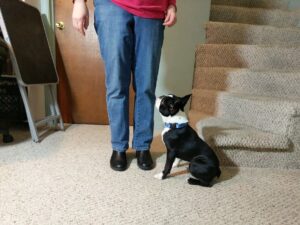Stairs are hard for dogs. They may mimic many human actions, but stairs don’t translate well from two legs to four. We can’t help them coordinate their motion. But we can teach our dogs to climb and descend stairs safely.
Stairs are common in houses, apartments, and most human living situations. But they don’t occur in nature, and they’re not something dogs inherently know how to navigate. Is your dog afraid or unwilling to climb or descend stairs? It’s only natural – all mammals, including humans, have an innate fear of falling. Dogs don’t understand the engineering behind stairs. They don’t know it’s the “easy” way to get where they want to go.
Look at the situation from your dog’s perspective. How would you feel if you had to climb an obstacle multiple-times your height? What if you had to do it several times a day? If it were something you’d never seen before? And you didn’t really understand the purpose?
Start at the very end
We’ve always had small dogs, so stairs are something that must be taught. Contrary to almost everything else in dog training, you don’t start teaching puppies or dogs stairs from the first step. Instead, you take the smallest chunk and teach your dog from there.
For teaching “up” the stairs, start at the first step from the top. Carry your dog to the top step. If you’re alone, stay behind the dog so there’s no chance they can go backwards – either by accident or on purpose. With another person available, have one behind the dog and one in front. Use the treats your dog values most for this training. Hold the treat above the top step, make sure the dog knows it’s there, and encourage him/her to climb that step. This is a behavior that can be lured.
If your dog is truly terrified of climbing up, reward for the slightest motion in that direction. Touching the upper step with one paw, two paws. Even looking at it, if it’s been a real issue. The point is to reward all progress in the right direction.
Lately we’ve noticed that many people in our classes asking too much of their dogs. They ask for something like “Come!” and rather than rewarding the dog for a speedy response, they pile on more stuff for the dog to do. Every single thing your dog does because you asked them to should be rewarded in some way. Even if all you do is say “Good dog!” please acknowledge their good effort. Stairs are hard for dogs and if you take your dog’s good behavior for granted, they may not bother.
Step by step

When your dog is comfortable with climbing one step, carry him to the second-from-the-top. Rinse and repeat, for as many steps as necessary. Once the dog catches on, they may not need a lesson for every step. That’s fine – you’ve achieved the objective.
Keep in mind that things people don’t really notice can be weird, different, and wrong to dogs. In our house, the steps take a 90 degree turn at the last four steps. Those are wedge-shaped, and not rectangular. To us, it’s just a little wider step at one end. To the dogs, it’s not the same as the rectangular ones above. If you can’t figure out why your dog hesitates at a certain point, look around and see how it’s different. It could be different because of shape, surroundings, floor covering, lighting, etc. And train it like it’s brand new. For your dog, it is.
Going down
By now you’ve probably figured out that the key to teaching dogs to go down steps is the same – one at a time. Because all animals fear falling, take your time and let your dog get comfortable. Carry them down to the first step from the floor so they only have one stair to go down. Reward when they do. When they’re okay with it, move to the second-from-bottom step. Rinse and repeat.
What brought stairs learning to the fore right now is having to start almost from scratch with Torque. Since he lost his eye, he also lost his confidence on the stairs. It’s the one area that seems to be hardest hit by the change.
Once again, his familiarity with the 2-Minute-Trainer program saved the day. In just a couple of sessions with single-step training, he was back to zooming up and down the stairs. Of course it helps that our training area is downstairs and it’s his favorite place in the world.






